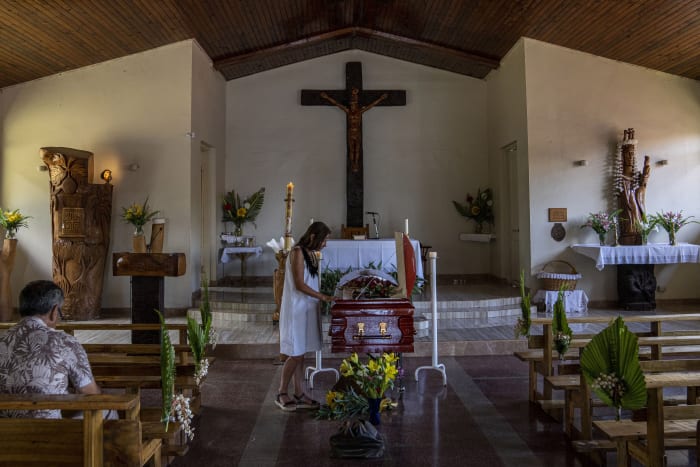RAPA NUI – Rapa Nui – the remote Chilean territory in the central Pacific widely known as Easter Island – is home to a Catholic Church with artwork reflecting the ancestral culture of these islanders as well as the Christian faith. Striking works include stained glass windows — created by a French-born artist — depicting figures resembling the residents of Rapa Nui.
Artist Delphine Poulain was born in Paris 52 years ago and has been in love with Rapa Nui since her first visit in 1994. She smiles at the memory of it.
“I was riding a horse across the beach when I first thought, ‘I want to live here,'” she said.
At the time, Poulain was living in Tahiti, working as a professional seaman and often traveling to other islands of Polynesia. One trip to Rapa Nui was enough to envision a future home in this land of extinct volcanoes and monolithic statues called Moai, although nearly three decades passed before that dream came true.
At times Poulain worked as a nurse. She became a boat decorator. She occasionally returned to Paris, but her fascination with Polynesia always brought her back to the Pacific.
On one of these trips back to France, she fell in love again with the man who had been her childhood friend. Now they have two children of their own and the four have been living in Rapa Nui since 2014.
Poulain says she appreciates the freedom and tranquility offered by the remoteness of the island, which is home to about 7,700 people.
Last year, Poulain presented a gift in gratitude for the blessings Rapa Nui bestowed on her: stained glass windows depicting the 14 Stations of the Cross at Holy Cross Church, located in Hanga Roa, the island’s capital.
Today, the Rapanui community is largely Catholic, but their religious practices are intertwined with the beliefs of their ancestors.
The musical themes sung by the faithful during Mass narrate biblical passages translated into the Rapanui language. The wooden statues depicting the Virgin Mary and the Holy Spirit were not inspired by Western iconography, but by the physique and heritage of the islanders’ ancestors.
The statue of Mary near the altar of the church resembles a moai. The third symbol of the Holy Trinity near the main entrance is not a dove, but a manutara – a bird that was considered sacred in the 19th century.
Adapting Catholic iconography to Rapa Nui’s ancestral culture was key to maintaining the religion, which was spread by European missionaries in the 18th century.
The Rapanui protect their identities and tend to only fully welcome foreigners if they make an effort to embrace the culture of the islanders. On a tomb outside the Church of the Holy Cross, where the bones of beloved missionary Sebastián Englert are kept, the epitaph reads: “He lived among us and spoke our language.”
Poulain said gaining the acceptance of the locals was not easy, but she had been patient. Her stained glass windows were another step along the way: since she began placing them in the church on December 24, 2021, some Rapanui who did not greet her before now wave their hands when they see her passport.
“I have so much respect for the island and the people,” she said. “I used to be alone, but now people know my husband and kids.”
Poulain’s commitment to integration with the island is part of her daily life. Her family lives on the beach where she dreamed of moving here a long time ago. The color of their house resembles the volcanic rock of the area so as not to alter the landscape. The water used at home is collected from rainfall. They rely on a solar panel for electricity.
When they moved here, the family only had a tent to shelter themselves. Now their home is a repository of what the island gave them.
The roof was built with sheet metal and the rest with wood. The dishes are washed on what used to be a bathtub floor; Above the dining room is a lamp that was once a metal rubbish bin.
“There were a lot of difficulties, but also a lot of luck. That was my dream and it’s incredible to be living your dream,” said Poulain.
In her studio, next to the makeshift desk, there is a tree that inspires the artist. Her work begins with sketches on a blank sheet of paper. Then she brings her pictures to the canvas with acrylic paint.
For the stained glass windows promised to the church, she needs a pigment that can only be found in France, so getting it takes time and she still has 10 of the 14 windows to finish.
Poulain never officially studied art. But her parents had books at home, and she remembers reading one about Mysteries of the World, which was the first time she learned about Rapa Nui. Her artistic style has changed over the years, but the Polynesian aesthetic has remained a constant
In addition to her artwork, Poulain has seven horses and earns some income by offering horseback rides for tourists.
Sometimes she sits outside her house, sipping wine and watching her horses approach for dinner. The scene could be an imaginary landscape from one of her paintings; Instead, her long-cherished dream comes true.
___
The Associated Press’s religion coverage is supported by AP’s collaboration with The Conversation US, funded by Lilly Endowment Inc. AP is solely responsible for this content.
Copyright 2023 The Associated Press. All rights reserved. This material may not be published, broadcast, transcribed or redistributed without permission.





